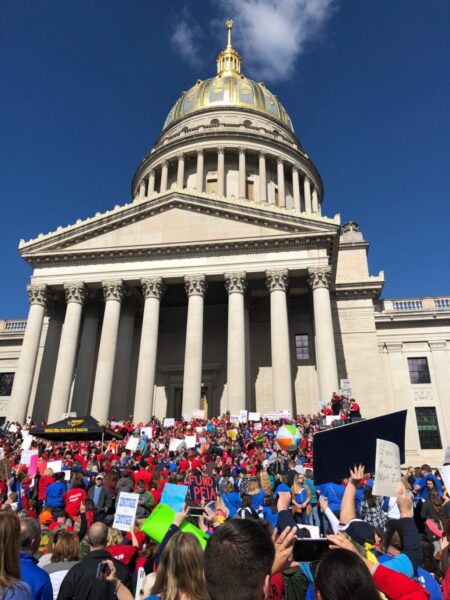The fight for justice has never been won at the ballot box alone. Resistance against the status quo is not uncommon in Appalachia; from the Mine Wars to the Red for Ed strikes, West Virginia has been center stage in pivotal events in this region. Bleak and seemingly-unwinnable battles are not unique to this state or its history. Rather, they are the norm. Resistance moving forward means learning from our collective past. It means strategically building coalitions and supporting our allies. It means finding leverage and applying pressure directly. It means seeing ‘unwinnable demands’ as unifying rallying cries for the majority people.
Elections and Resistance
 It’s easy to become despondent after an election. In West Virginia, we’re conditioned to feel that sense of disappointment regardless of the outcome. Fatalistic attitudes color our thinking, perpetuating the notion that nothing will ever change. In the 2020 election only 57.6 percent of eligible West Virginia voters cast a ballot, up a scant half a percent from 2016. Of all states within Appalachia, West Virginia’s turnout was the lowest this year.
It’s easy to become despondent after an election. In West Virginia, we’re conditioned to feel that sense of disappointment regardless of the outcome. Fatalistic attitudes color our thinking, perpetuating the notion that nothing will ever change. In the 2020 election only 57.6 percent of eligible West Virginia voters cast a ballot, up a scant half a percent from 2016. Of all states within Appalachia, West Virginia’s turnout was the lowest this year.
One may point fingers and proclaim that the fault lies with voters or with politicians. Had voters been energized to get out and cast their ballots then they would have done so, some argue. But, because voter turnout remains so low, politicians have no incentive to make or carry out bold promises. The cycle feeds itself until everyday citizens become defeated, opting to accept their fate and the despair of futility.

Red for Ed(ucation) protest at WV State Capitol. Photo by Dani Parent.
Yet within this despair lies a precedent for hope. In West Virginia, that hope is found in the history of resistance this state and our people have to offer. From the Mine Wars to the Red for Ed strikes, West Virginians have never allowed their fates to be dictated by the wealthy, the powerful, or the political class. Those events are symbolic of the two sides of Appalachian identity—creating inspirational movements that challenge authority directly, and retreating when the system isn’t struck down. Following the Mine Wars, for example, a wave of anti-union repression took hold in the coal-rich southern counties, and it was more than another decade until union density among coal miners would peak yet again following the election of FDR. Similarly, the victory of the 55 Strong movement failed to force Republicans’ hands into accepting a long-term solution to PEIA, but they won increased pay for all public employees and stand organized and ready to defend PEIA in the coming years.
Resistance doesn’t have to come through the ballot alone. Resistance of authority is the lifeblood of the Mountain State. Rather than heap ash upon our faces post-election, we must remember our history of successful resistance against the odds.
History and Success
In the 1960s, before the term “black lung” was widely used, miners often relied on the good will and aid of others when they became too sick to work. Early deaths were not uncommon for those working in the recently-mechanized industry. The Black Lung Association’s triumphant battle to receive federal recognition of the disease and the benefits miners so desperately deserved was a fight that took both union leadership and conservative lawmakers.
By 1989, the UMWA that had been transformed by the formation and success of Miners for Democracy went on a 10-month, cross-state strike against the Pittston Coal Company. Virginia’s Democratic Governor, Gerald Baliles, repeatedly took the side of Pittston over the miners. A combination of direct action tactics, including occupying Moss 3 and destroying coal trucks, as well as media spotlights and cross-labor organizing gave the UMWA its last and most impressive victory in the 20th century.
Only one month after this victory, West Virginia teachers called for their first statewide strike in history. The 1990 teachers strike that followed Pittston was aided by triumphant UMWA members who donned their camouflage shirts to join educators at rallies in Charleston. An intransigent legislature and immoveable governor were met with the full-force of parent advocates, community members, and labor solidarity. The strike ended after eleven days with yet another victory for labor during an era of Reaganomics.
Despair and Hope
Four years ago despair gripped the hearts of many Appalachians, but post-election in 2016 was no time to be complacent. Katie Hancock, a social worker in Kentucky, knew she had no legal protection for voicing her opinion about then-Governor Bevin’s new warpath: decimating the public employees pension program. As an activist, however, she also knew she couldn’t remain silent. Hancock created a secret online Facebook page, United We Stand, as an outlet for public employees to vent their frustrations and share updates about Bevin’s plans. At a November 2017 rally, United We Stand brought together union members, educators, and activists to block Bevin’s attempts to overhaul the public employee pension system during a special session, a major victory in a state where such actions are unprotected.
West Virginia teachers likewise created a private Facebook page that began as a small group of teachers sharing updates about the public employee health insurance plan (PEIA) and calling for equalized pay. The page grew exponentially and was used to plan walk-ins and walk-outs, share minute-by-minute updates on the goings-on in the legislature, and worked in tandem with on-the-ground organizing to affect outcomes—they won increased pay for all public employees and blocked an attempt to increase PEIA premiums and deductibles.
In both Republican-dominated states, in deep-red Trump country, and completely against the odds, public employees found the strength to build a united front and stop the worst effects of austerity measures and begin the Red for Ed movement. Ryan Cooper, writing in The Week, had this to say at the time: “This could be the start of a grassroots revolt against plutocracy in both parties—coming from a place few people expected. Nobody can say where it will lead, but at the very least we all must watch carefully to see.” Two years later, the Red for Ed movement that began in Appalachia has spread to dozens of cities and states in the US alone, with international educators taking their cues from Appalachia as well.
Final Thoughts
What can we learn from our past to help us envision a better future? First, the conditions for resistance are always right under the surface. Many already feel a sense of aggrievement and the sense that something isn’t right. Trump played to that anger successfully from the right four years ago, yet it didn’t work for him this time because aggrievement alone can’t build a movement. Rather, resistance against the unjust requires a clear plan of action. What made movements of West Virginia’s past successful was that their actions we defined by the voices of the many, built on collaboration and defined by their empowerment of regular folks.
Furthermore, coalition-building brought together those who otherwise may not have seen themselves in this fight. Katie Hancock could not have envisioned that United We Stand would morph into a powerhouse group for educators, capable of mobilizing on a statewide movement against Governor Bevin, nor could West Virginia teachers have envisioned that grievances over health insurance would spark a nationwide revolt. Had they siloed themselves and made their issues narrow, they could not have folded in so many voices, would not have prioritized raising up those who could not speak for themselves, and they would not have affected such outcomes. This same spirit of inclusion is was what made Miners for Democracy a possibility. It’s what gave striking Pittston workers new hope. It’s what kept West Virginia teachers out of the classroom for eleven eventful days in 1990. And it’s what we must focus on now.
The next two years will be tough, there’s no denying that. On the chopping block are a host of environmental regulations that our lawmakers are all too eager to roll back. ALEC-sponsored bills will undoubtedly make it to committees where they’ll be rubber stamped for quick approval on the floor. But as with all progress made in our state’s history, nothing will change unless we learn from those who came before us, nothing will change unless we organize. History shows we know how to do that!










